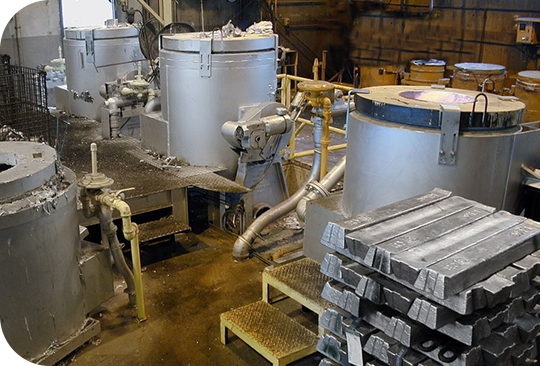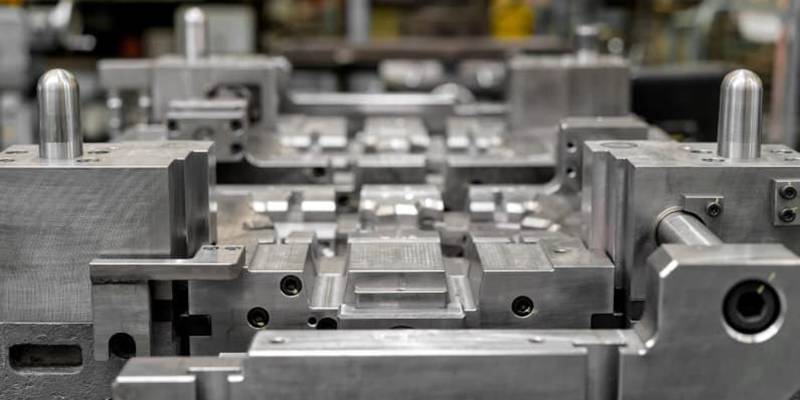Aluminum Casting safety tips for manufacturers and workers
Everything You Need to Find Out About the Uses and Benefits of Aluminum Castings
Aluminum castings play a necessary function throughout numerous markets, offering unique residential or commercial properties that improve product efficiency. Their lightweight nature and strength make them suitable for applications in automotive and aerospace sectors. Additionally, the adaptability of casting techniques permits for intricate designs and tight tolerances. As the need for sustainable remedies rises, understanding the benefits and applications of aluminum castings becomes progressively vital. What specific advantages do they offer over other materials?
Overview of Aluminum Casting Processes
Aluminum casting procedures encompass a range of strategies utilized to shape liquified aluminum right into desired forms. These techniques consist of sand casting, die spreading, and financial investment spreading, each offering distinct advantages depending on the application (Aluminum Casting). Sand casting entails creating a mold from sand, enabling for complex designs and big parts, while die casting utilizes high stress to inject molten aluminum right into metal molds, ensuring precision and smooth coatings. Financial investment spreading, additionally referred to as lost-wax casting, generates intricate shapes with outstanding dimensional precision, making it ideal for detailed elements
These procedures are characterized by their capability to produce light-weight, sturdy parts that display excellent rust resistance. The adaptability of aluminum permits for customization in different markets, from automobile to aerospace. In addition, the ability to reuse aluminum improves the sustainability of these casting processes, minimizing ecological influence while keeping product honesty. Understanding these techniques is crucial for optimizing manufacturing efficiency and accomplishing premium aluminum castings.
Secret Applications of Aluminum Castings
Aluminum castings play a necessary duty throughout various industries, specifically in vehicle, aerospace, and consumer electronic devices. In the auto industry, they contribute to light-weight frameworks that boost gas effectiveness. In a similar way, aerospace elements gain from aluminum's strength-to-weight proportion, while consumer electronics utilize its adaptability for effective production.
Automotive Industry Applications
As the automotive sector remains to develop, producers increasingly rely upon aluminum castings for their light-weight yet long lasting residential properties. These castings play a vital duty in improving car performance, fuel performance, and general safety. Key applications include engine blocks, transmission housings, and architectural elements, which take advantage of aluminum's superb strength-to-weight ratio. Additionally, aluminum castings facilitate intricate geometries, permitting cutting-edge styles that enhance aerodynamics and lower drag. The rust resistance of aluminum likewise adds to longevity, lowering upkeep expenses for both manufacturers and consumers. As electrical vehicles gain popularity, aluminum castings are necessary for battery enclosures and various other parts, better solidifying their importance in the future of vehicle production.
Aerospace Component Manufacturing
In the aerospace sector, aluminum castings are integral to the manufacturing of light-weight, high-performance components. These castings are vital for manufacturing parts such as engine real estates, architectural frameworks, and landing equipment parts, where weight reduction is crucial for fuel effectiveness and total efficiency. The exceptional strength-to-weight ratio of aluminum permits for the development of intricate geometries that boost aerodynamics. Additionally, aluminum's resistance to rust adds to the durability and reliability of aerospace parts, making sure safety and security in flight procedures. The spreading procedure likewise permits for accurate tolerances, which is essential in meeting stringent aerospace market requirements. On the whole, aluminum castings play a critical role ahead of time aerospace modern technology while sustaining the sector's push for lasting techniques.
Customer Electronics Manufacturing
The usage of aluminum castings in customer electronics manufacturing has come to be increasingly substantial because of their light-weight and long lasting properties. Makers leverage these castings to create components for different gadgets, consisting of mobile phones, laptop computers, and gaming consoles. Aluminum's superb thermal conductivity also assists in warm dissipation, boosting device performance and longevity. In addition, the flexibility of aluminum enables elaborate styles and intricate geometries, allowing smooth and modern-day aesthetics that attract customers. Additionally, aluminum castings can be conveniently reused, lining up with the growing need for sustainable production methods. As technology advancements, the duty of aluminum castings in establishing ingenious and efficient customer electronic devices is expected to increase, making them a staple in the industry.

Benefits of Using Aluminum Castings
While various materials are available for spreading, aluminum sticks out due to its one-of-a-kind mix of lightweight buildings, toughness, and deterioration resistance. The reduced density of aluminum makes it a perfect choice for applications where weight decrease is essential, such as in the automotive and aerospace industries. Its superb strength-to-weight proportion allows makers to produce durable components without including extreme weight.
In addition, aluminum castings can be generated with complex designs and tight tolerances, allowing intricate geometries that are challenging to accomplish with various other products. The adaptability of aluminum permits numerous casting methods, including sand, die, and financial investment casting, catering to varied production demands. Furthermore, aluminum's simplicity of machining and finishing enhances its charm, assisting in the production of premium surface area finishes. On the whole, the advantages of using aluminum castings add to enhanced efficiency and performance in many applications throughout different fields.
Deterioration Resistance in Aluminum Castings

All-natural Oxide Layer
An all-natural oxide layer types on the surface of aluminum castings, offering a necessary obstacle versus environmental factors that can cause wear and tear. This thin, protective movie is an outcome of the aluminum's reaction with oxygen in the air, properly protecting the underlying steel from moisture, chemicals, and pollutants. As an outcome, aluminum castings exhibit outstanding corrosion resistance, which enhances their durability and sturdiness in different applications. The oxide layer is not just advantageous for security but also adds to aesthetic top qualities, as it can create a matte coating that numerous markets like. Furthermore, this all-natural procedure reduces the demand for added finishings, making aluminum castings an affordable selection for makers looking for reputable, resilient materials.
Alloy Variations Influence
The structure of aluminum alloys substantially affects their imp source deterioration resistance buildings in castings. Various alloy variants, such as 1xxx, 2xxx, and 6xxx series, show distinct degrees of sensitivity to corrosion. For example, 1xxx alloys, mostly made up of pure aluminum, offer excellent rust resistance as a result of their high pureness. In contrast, 2xxx alloys, which include copper, may experience significant deterioration when exposed to severe environments. 6xxx alloys, incorporating magnesium and silicon, strike an equilibrium in between strength and resistance. The existence of alloying aspects can enhance or diminish safety oxide layers, ultimately impacting durability and efficiency. Understanding these variants is important for selecting the appropriate alloy for particular applications where rust resistance is essential.
Layout Versatility and Modification
Although numerous products exist for casting applications, aluminum stands out as a result of its impressive layout versatility and possibility for modification. This adaptability enables developers and designers to develop complex forms and forms that meet certain functional demands. Aluminum Casting. The low density of aluminum allows light-weight designs, which is specifically valuable in markets such as auto and aerospace, where weight reduction is essential
Aluminum castings can be customized to different specs, consisting of wall thickness, surface area finish, and dimensional resistances. This flexibility not only improves the aesthetic appeal but also enhances the performance of the last product. In addition, advanced strategies such as 3D printing and computer-aided design (CAD) additional assist in the customization process, making it possible for fast prototyping and lowering preparations. Consequently, aluminum castings can properly satisfy the varied demands of various industries while supplying makers the capability to innovate and respond rapidly to market demands.
Contrast With Other Casting Products
While different casting products each have their distinct benefits, aluminum regularly demonstrates exceptional properties that make it a preferred selection in several applications. Compared to iron and steel, aluminum is considerably lighter, which reduces the total weight of finished products, improving fuel efficiency in auto and aerospace industries. Aluminum offers superb deterioration resistance, calling for much Continue less upkeep over time contrasted to products like iron, which can rust.
When compared with plastics, aluminum's stamina and longevity go beyond many synthetic options, making it ideal for demanding settings. Furthermore, aluminum's thermal and electric conductivity is extremely greater than many various other steels, making it ideal for applications calling for efficient heat dissipation or electrical elements.

Future Fads in Aluminum Casting Innovation
Improvements in aluminum spreading modern technology are readied to redefine its applications across different sectors. Advancements in automation and robotics are simplifying manufacturing procedures, boosting efficiency and precision. The assimilation of expert system and artificial intelligence makes it possible for real-time surveillance and predictive upkeep, reducing downtime and improving quality assurance.
Moreover, the advancement of innovative alloys is broadening the performance capacities of aluminum castings, making them ideal for more requiring applications, particularly in automotive and aerospace sectors. Sustainable techniques are likewise getting grip, with enhanced focus on reusing aluminum and reducing carbon impacts during production.
Additive production strategies, such as 3D printing, are being explored to create complex geometries that conventional techniques can not achieve, permitting higher style flexibility. These patterns show a future where aluminum casting will certainly not only satisfy but exceed industry assumptions, driving technology and sustainability in production.
Regularly Asked Concerns
Exactly How Are Aluminum Castings Recycled After Usage?
Aluminum castings are generally collected, cleansed, and refined in recycling centers. The material is thawed down, improved, and afterwards reformed right into brand-new items, consequently preserving sources and decreasing environmental effect while preserving aluminum's desirable residential properties.
What Are the Typical Expenses Connected With Aluminum Castings?
The normal costs connected with aluminum castings vary based on factors such as intricacy, volume, and product requirements. Normally, rates range from a few dollars per pound to significantly greater quantities for intricate layouts and large amounts.
How Do Aluminum Castings Contrast in Weight to Steel Castings?
Aluminum castings evaluate considerably less than steel castings, typically around one-third the weight (Aluminum Casting). This lowered mass enables simpler handling, transport, and application in various sectors, adding to improved effectiveness in style and manufacturing processes
What Industries Primarily Count On Aluminum Castings?
Various sectors significantly depend on aluminum castings, consisting of vehicle, aerospace, electronics, and customer products. Their light-weight nature, corrosion resistance, and versatility make them essential for producing parts in these fields, enhancing efficiency and effectiveness.
Exist Any Health Dangers Linked With Aluminum Casting Processes?
Wellness threats related to aluminum casting procedures consist of direct exposure to fumes, dirt, and chemicals, which can bring about respiratory system problems and skin inflammation. Correct security measures and tools are vital to alleviate these prospective hazards in the office.